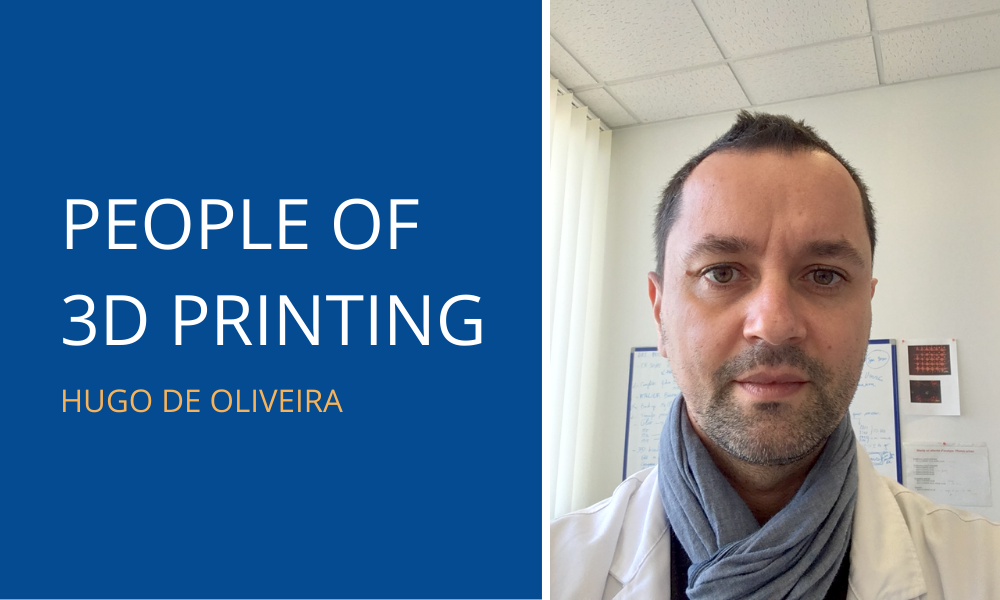People of 3D Printing: Hugo de Oliveira
Posted By Emma Moreau on Jan 12, 2021 | 0 comments
Who is Hugo de Oliveira?
Hugo de Oliveira is a research engineer (IR) at Inserm’s “Research accelerator for Bioprinting technologies” (ART BioPrint, www.artbioprint.fr), a research structure part of Inserm U1026, devoted to the application of 3D bioprinting for biological applications.
Hugo, can you tell us more about your background and how you got to 3D printing?
I am a Biochemist by training, and then I’ve developed a PhD in Biomedical Engineering. For the last decade, I have developed expertise in biomaterial development, nanotechnology, tissue engineering, and biofabrication at the interface between chemistry and biology. The use of 3D bioprinting comes naturally in my pathway due to its inherent capacity to gain further control over cell/biomaterial deposition and attain additional complexity.
When and why did you/your institution start using 3D printing?
3D bioprinting has a long history in my institution (Inserm U1026), particularly laser-assisted bioprinting (LAB), initiated in 2005 by Fabien Guillemot (Founder and CEO of Poietis company, www.poietis.com) where he set the first seeds for the use of this powerful technology for tissue engineering applications.
Can you tell us more about 3D printing applied living organisms thanks to the bio-printing technique?
Bioprinting is now focused on two main fields, the fabrication of advanced in vitro models (organoids, cancer models, tissue models, organ-on-chip) and the biofabrication of living tissues for regenerative applications. In both applications, bioprinting is a technology that provides extra control on the fabrication process, enabling automatization, standardization, and finer control over the 3D deposition of cells and biomaterials, as means to modulate their survival, phenotype, and maturation in time.
What motivated you/your institution to start working with bio-printing materials?
I think for most people working on tissue engineering and 3D culture of cells, bioprinting has become a tool of choice to address unsolved problems of classical “top-down” approaches. We, and others, have indeed profited from the combination of classical 3D printing and/or several bioprinting technologies (Laser-assisted bioprinting, microextrusion, inkjet, etc.) to achieve higher complexity of the fabricated tissues.
What are the technologies and materials you are working with?
We have been using the three main bioprinting technologies, namely laser-assisted bioprinting, microextrusion, inkjet/microvalve, alone or combined, and the classical 3D printing of thermoplastics. Our vision is that no technology is better than the other. Usually, one or a combination of several are better adapted to respond to a specific bioengineering solution. For this purpose, we have developed biomaterial inks, mainly derived from the extracellular matrix and combined with biologically active peptides, to sustain the optimal cellular response.
What are the advantages of 3D printing in your area?
With the risk of repeating myself, the main advantage is control in the process of biofabrication. It is now clear that cells respond to a wide range of stimuli drawn from the extracellular matrix and other cells present in their vicinity. In this sense, the precise control over cell positioning, cell density and distance, extracellular matrix composition and density, capacity to control nutrients, and oxygen diffusion present an advantage in creating 3D living systems.
What is your point of view on the future of 3D printing?
3D printing has become a widespread technology, available nowadays at all levels of society. In the last years, we have seen a drastic reduction in its cost, while novel technological applications appear every day. In the medical field, 3D printing has become a widespread tool to enable surgeons to plan more effectively, reducing surgery duration and, therefore, the patient burden with an interesting cost.
In what concerns bioprinting, and despite the long journey ahead before complex organs can be effectively bioprinted, this technology will surely be crucial to establish future GMP procedures for the production of pre-clinical in vitro models or in the field of tissue engineering. Again, and in my view, the main added values are standardization, automatization, and control.
At some points, we are still in the infancy of the potential for these technologies. The future is bright!


 Connect with Google
Connect with Google Connect with Facebook
Connect with Facebook